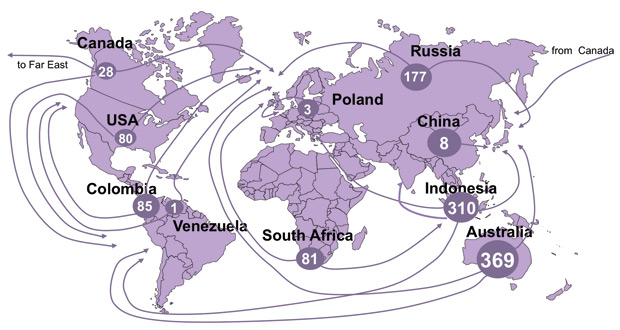According to provisional calculations by the German Coal Importer Association (VDKi) in Berlin, global trade in coal rose 1.5 % in 2017 to 1,140 mt, while worldwide demand for coal increased by 2 % to reach 6.9 bn t. Following a decline in 2016, which the International Energy Agency (IEA) recently reported on, supply and global trade have rallied. The USA’s seaborne exports alone saw a rise of 30 mt (60 %). Sea trade increases were also registered by Russia and South Africa, both at 7 %. South Africa, formerly an important supplier to Europe, now sends the majority of its exports to countries in Asia (Figure 1).
The decline in production in 2016 was mainly brought about by the difficult circumstances in the USA, where there was a series of insolvencies, and by the closure of unsafe mines in China. In 2017, however, both countries saw renewed growth, with the USA registering a 7 % increase and China 2 %. Mining in India also witnessed a sharp rise (+3.2 %).
The increase in global trading volumes of coal is primarily attributable to the growing demand in the ASEAN states, where the manufacturing industries are witnessing continual growth. The construction of modern coal-fired power plants and a growing steel industry are generating extra demand for coking coal and steam coal. The development models in these countries are, similarly to China, built on coal and will not be supported by renewable energy sources for some time yet.
Bucking the global trend, German coal imports have declined sharply by around 10 % or 6 mt. Though imports of coking coal were up by 0.6 mt and coke imports were up by 0.3 mt, the use of these resources in electricity generation actually fell by roughly 15 %, equivalent to almost 7 mt. The main reason for this is the almost relentless expansion of wind farms in a year of exceptional wind output. In 2017, the contribution made by onshore wind turbines to the gross electricity generation rose by 30 % or 2 % points, while the offshore wind contribution grew by 47 % or 1 % point. By contrast, the proportion of gross electricity generated by coal fell by 17 % (3 % points) in 2017.
These figures provide compelling evidence that the phase-out of coal power generation is already under way and no further government intervention is required. Nevertheless, coal-fired power plants are still urgently needed to support the volatile supply levels of renewable energy sources, even if their output is falling. To this end, coal-fired power plants must be granted fair access to capacity markets. The latest decisions of the European Council of Energy Ministers fall short in this regard. Neither coal power plants nor gas turbines can operate within the planned CO2 limits. The highly efficient gas and steam turbine power plants are only constructed in connection with industrial combined heat and power systems or district heating, not to offset the fluctuating supply of renewable energy sources. If the European Union sees out its plans, it will seriously jeopardise the reliability of supply in Europe. (VDKi/Si.)


